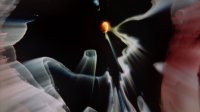
Look Closer
Chris Parks Art | Vision3
Chris's pursuit of achieving what would normally be considered VFX shots, in camera, doesn't stop at his fluid effects and cloud tank photography. Whether designing specialist optics to get the right shot, using aerial imagery to bring out of focus backgrounds into the same focal plane as close ups, or using techniques like Gaussian Splatting to create digital assets in camera, Chris is a champion of in camera techniques.

Ant Man and the Wasp: Quantumania
Peyton Reed | Marvel Studios
Ant Man VFX supervisor, Jesse Chisolm, approached Chris about creating skies for the Quantum Realm. They were looking for something organic that suggested the sub atomic scale of the world. Chris shot for two weeks creating environments and the imagery for the credit sequence.

Poor Things
Yorgos Lanthimos / Searchlight Pictures
The incredible tale about the fantastical evolution of Bella Baxter, a young woman brought back to life. Chris was approached by the production to provide events to represent otherworldly skies for this incredible film. The shots used fabric movement, ocean currents and microscopic processes as inspiration for their form.

Tree of Life
Terrence Malick | Fox Searchlight
In the 1980's, when Terrence was in the early stages of planning his epic film, he approached Peter Parks to shoot some marine imagery. 30 years later once principal photography was under way he got in contact with Chris to shoot some abstract imagery for the 'Life before birth' and 'Universe before the big bang' sequences.

Assassins Creed
Justin Kurzel | Regency Films
The director, Justin Kurzel, brought in Chris to create visuals to represent memory and past experiences. Chris drew on the double helix idea of DNA where particularly violent memories are stored Chris developed variations on this visual style for The Animus as a signature for time travel as well as a visual representation of memory itself.
Short Films & Commercials


Apple
Director: Henry Hobson
As part of the launch of the iPhone 7, Apple created a film highlighting some of its key functions. Chris collaborated with Henry Hobson to create unique imagery that matched the key messages which included stereo sound, unique black finish and low light camera ability. It was the first time that Chris had worked purely in black and white.

Rolls Royce
Director: Sam Pilling
When Sam Pilling and Pulse decided to project images of the Aurora Borealis onto the Rolls Royce Phantom, they came to Chris to create the imagery. Using a combination of modern day glassware and some 200 year old lenses, Chris and the team were able to achieve miniature Auroras in no more than a cup of fluid.

Moët et Chandon
Director: Manu Cosu
For Moët et Chandon and their 'Must Be Moet' worldwide campaign, Chris was again asked to create visuals to suggest something abstract - in this case it was 'the memorable moment', those instances in life when everything comes together into something unforgettable. Directed by Manu Cosu the results are truly stunning.

Console Glass
Director: Fausto Becatti
Chris worked with Bioscope films to create the manufacturing of not only the glass bottle but also the contents that fill it. Chris used both his signature fluid events for the sequence but also shot some of the raw ingredients, including sand, silica and glass.

